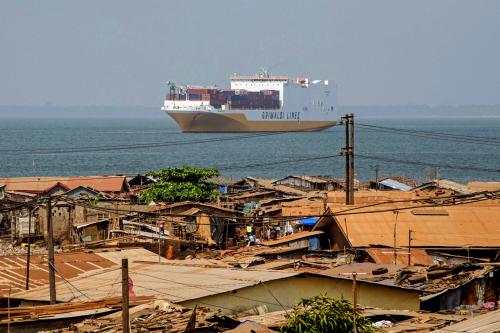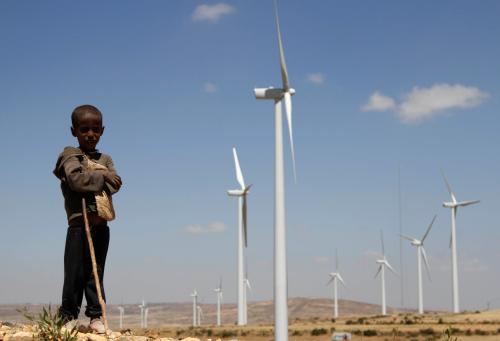Virtually every strategic document for improving economic outcomes in sub-Saharan Africa—for example, Germany’s January 2017 Marshall Plan—lists the following priorities: creating jobs for Africa’s burgeoning youth, bringing women into the labor force, moving up the value chain to first processing rather than simply exporting commodities, improving food security, responding to climate change, and addressing the massive infrastructure deficit, especially in transport and power. These compelling goals overlap with the United Nations Sustainable Development Goals (SDGs) and the High 5s of the African Development Bank (AfDB).
These plans also emphasize leveraging private sector resources and strengthening domestic revenue mobilization as essential to taking Africa forward.
But for this to happen, African governments have to put in place certain basics. These key lessons from emerging markets include keeping public debt sustainable and creating a solid foundation for long-run growth based on good governance, selfless leadership, and strong institutions. It is doubtful that the private sector will propel long-run growth in Africa in the prevailing environment. It is more likely to focus on short-term opportunities. Nor will ramping up domestic revenue mobilization yield the expected benefits absent ironclad assurances, now seriously lacking, that the government will use the money well.
A trillion dollars needed every year
At the same time, the development financing needs are vast. The U.N. Conference on Trade and Development 2016 Economic Development report for Africa notes that financing the SDGs could require investments of between $600 billion and $1.2 trillion per year. Infrastructure alone will cost $93 billion, of which Africa can raise only half. These are formidable numbers, especially in view of the constraints donors face as noted in an earlier companion blog post on the prospect of less concessional development finance.
Our working paper on the development and debt sustainability implications of less concessional finance identifies a three-pronged plan to propel Africa forward.
First, a relatively small amount of the official development assistance now going to Africa can be securitized to raise a sizable sum of money. Here’s the math: With the yield on the U.S. 30-year Treasury well below 3 percent, setting aside less than $5 billion per year for the next 30 years—about 11 percent of the annual $45 billion in grants now given to Africa—will enable $100 billion to be raised upfront via a big bond. While this sum is large in relation to current annual aid flows, it is small relative to the financing needs outlined above.
Second, this money can be on-lent using moderately concessional loans (MCLs). This will serve two purposes. First, it will lower the fiscal burden on donors as a portion of grants is converted into loans. Second, it will bolster debt sustainability, as MCLs will be superior to eurobonds and of far longer maturity than domestic market borrowing, which in many cases is at exceptionally high real interest rates.
There should be no automatic eligibility for these loans. Countries seeking access should be required to show that they have the absorptive capacity and a program for putting and keeping public debt on a sustainable trajectory. These conditions would apply to countries like Ghana, Mozambique, and Zambia, which have issued eurobonds and would therefore benefit from MCLs on cost and maturity grounds, must overcome serious, mostly self-inflicted, debt sustainability challenges. Others such as Guinea and Togo could demonstrate their commitment to reform, which then opens up access to finance for their ambitious public investment programs. With some countries still needing access to highly concessional finance, a two-tier approach will be needed, with the current performance-based allocation system targeted at countries not eligible for MCLs but with incentives for them to make the grade over time. Details are discussed in our working paper.
Third, there needs to be an enhanced policy dialogue. The current policy dialogue and aid allocation framework are not adequate. The new policy dialogue should utilize the International Monetary Fund and World Bank’s Debt Sustainability Framework and the World Bank’s Country Policy and Institutional Assessments. But it will need to be a lot more candid, with an explicit focus on governance, institutions, and leadership. Given the political sensitivity of these topics, this dialogue should be led by the AfDB as Africa’s development bank, in close collaboration with the IMF, World Bank and other development partners such as the African Union and New Partnership for Africa’s Development (NEPAD). Key topics should include public debt sustainability, growth policy, and prudent use of natural resource wealth, which now tends to be squandered.
In a fragmented region, the most fragile countries need special attention
The $5 billion set aside to service the big bond should not be at the expense of fragile countries, which should continue to benefit from highly concessional finance under the existing allocation rules. Regional infrastructure projects are an obvious way of using a significant chunk of the big bond’s proceeds, thereby helping reverse the arbitrary fracturing of the continent as exemplified by the 1885 Berlin Conference noted in Germany’s Marshall Plan report.
Such projects will benefit all countries, including the poorer ones. But there is a surprising lack of “shovel-ready” bankable regional projects. To some extent, this is a chicken-and-egg problem. Regional infrastructure projects are big by nature and need large sums of money to prepare. The $50-80 billion Grand Inga Dam project is an example, heralded as a venture that could power half of Africa. Yet it is also controversial; the World Bank suspended financing for it in July 2016. But even if all the engineering and environmental issues could be fixed, the Inga Dam is located in the Democratic Republic of Congo, with its weak governance and leadership.
Because of the imperative of integrating the continent, the governance challenge in Africa transcends the national, a fact recognized in the agendas of the African Union and NEPAD. Only Africa and its leaders can resolve coordination and governance issues. But donors can play a catalytic role. This should start with a brutally honest acknowledgement that the present system governing official development assistance is delivering neither debt sustainability nor long-run growth. And both Africa’s leaders and development agencies have to recognize that African growth will eventually need to be self-financed. This is exactly the rationale for the package consisting of the big bond, MCLs, and enhanced policy dialogue.
Sending a message
As important as the interest that the $100 billion will inevitably stir up among infrastructure companies worldwide are the signals it will send: Africa is open for business, donors are committed to maintaining Africa’s momentum with a big push on infrastructure and human capital without increasing their own fiscal burden, and, in a partnership of equals, the world expects African leaders to do the heavy lifting.
Luisa Teixeira Felino is a Young Professional at the African Development Bank (AfDB) and Brian Pinto is an adviser to the ADF Policy Innovation Lab headed by Aloysius Ordu and financed by the Bill & Melinda Gates Foundation through a grant administered by the AfDB. The views herein are those of the authors and not necessarily shared by the AfDB.





Commentary
A bridge to African self-reliance: The big bond
October 17, 2017